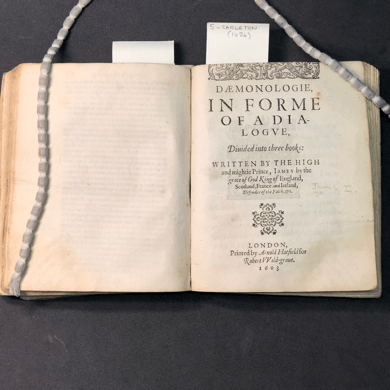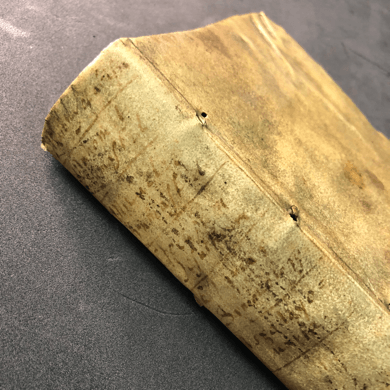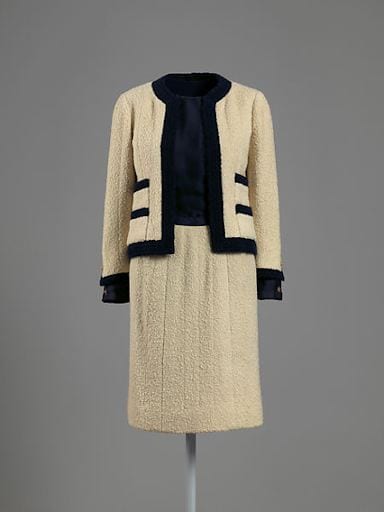[Last modified: March, 25 2019 11:06 AM]
You, me, your parents and friends all believe in something. Whether it is in aliens, the existence of God (or lack thereof), scientology or Bigfoot, we accept that one thing or the other is true. As a result, we give that idea power. A power only made greater by numbers. Ideologies are a system of ideas and ideals that are reinforced through these numbers. Numbers of people create numbers of objects that reproduce the ideological message and, hopefully, reach an audience.
Religion: Protestant Reformation
Name: Dæmonologie, : in forme of a dialogue, divided into three books: written by the high and mightie prince, Iames by the grace of God King of England, Scotland, France and Ireland, defender of the faith, &c. by James I, King of England (1566-1625), 1603
Published: London, by Arnold Hatfield for Robert Vald-graue
Binding: limp parchment wrapper, completely detached from text block
Object ID: STRONG ROOM B 1624 M1/4
This book is actually a collection of five different works from the 1600s that were miraculously brought together. Apart from Dæmonologie, the book’s contents include Mahomet Unmasked, Miracles Unmasked, Speculum Jesuiticum and Astrologomania. Originally separately published, they were cropped and re-bound together.
The yellowing artefact is pebbled with markings and drawings of little fingers pointing out interesting parts of the text. The cover is completely detached. Water has severely damaged the bottom corner of the pages in the back of the book, a lot of which are also torn. These texts were brought together but now they are falling apart.
Anti-Islamic propaganda. A denouncement of astrology opening the eyes of Christians who have been bewitched by sorcery. A criticism of the Catholic Church. These are some of the subjects tackled in this unlikely compilation. The barely legible titles on the yellow spine do little to tell their story. What do they have in common?
They mark the rise of the Protestant movement when the Church of England broke away from the Roman Catholic Church. Each one is a reproduction of Protestant convictions. They are different strands of ideas that have emerged from the same origin – the Protestant ideology. Yet this book is not only significant in its ideological reproduction: it stands for physical reproduction.The five originally separate works were taken and reproduced in a new form – the one that currently lies in UCL Special Collections. Now the authors not only share their beliefs but they also share a binding.
Politics: Adolf Hitler’s Struggle
Hitler, Mein Kampf: Eine kritische Edition by Adolf Hitler, Christian Hartmann, Thomas Vordermayer, Othmar Ploeckinger, Roman Toeppel, 2016
Ethical Considerations: It is important to consider the ethical implications of reproducing ideologies of the past in a modern context. We would like to note that our inclusion of Hitler, Mein Kampf: A Critical Edition in this exhibition does not support or endorse the fascist ideology in any way. It also does not normalise the events of the Holocaust and Nazism in general by displaying them next to ideologies of Protestantism and feminism. Instead, we aim to explore their significance in society as various parts of history that were reproduced through time. We would advise our audience to be respectful and cautious when discussing and considering the role of fascist ideologies both in the past and modern day. Please contact our Visitor Experience Team if you have any concerns or questions about this object.

Adolf Hitler was a dictator, German politician, Nazi and author. Mein Kampf, or My Struggle, an autobiography that he started in jail, was first published in 1925. After his death, the rights to the anti-Semitic text were transferred to the state of Bavaria, where he lived. The authorities warded off any attempts to publish it out of fear that the book would give rise to a new wave of Neo-Nazism.
However, at the end of 2015 the copyright on the text expired and the 70-year ban was lifted. Hitler, Mein Kampf: A Critical Edition was published in 2016 with 3,500 historical annotations to the original edition. It sold 85,000 copies and spent 35 weeks on Der Spiegel’s best-seller list.
Fascism has left a terrifying and disturbing mark on recent history. Concentration camp survivors, museums, memorials and memoires still remind us of the tragic horrors that were brought upon millions of victims during the Holocaust. So why would such a hate-filled and dangerous text as Mein Kampf be re-published in the 21st century?
The reproduction of the text sparked ferocious debates in which the text’s defenders argued that it puts this history into context. In fact, the Institute of Contemporary History in Munich reported that a large portion of the readers were those interested in politics and history. After all, knowledge is power. Re-illuminating the events that were driven by that ideology and re-educating the public about its dangers could prevent history from repeating itself. This becomes especially critical in the modern day, when right-wing politics and racist slogans are gaining popularity every day.
The importance of the new edition is the additions it carries. It is an altered reproduction of the original. A better reproduction of the fascist ideology because it condemns it. We cannot ignore the past, even if we destroy its historical evidence. Instead, we can re-interpret historical artefacts and give them new meaning and purpose.
Fashion: Chanel’s Feminist Suit
Name: Suit, ca. 1962
Design House: House of Chanel
Designer: Gabrielle Chanel (1883-1971)
Material: wool, silk, metal
Collection: The Metropolitan Museum of Art
Object ID: 2009.300.525a-e
Name: Ensemble, fall/winter 2015-2016
Design House: House of Chanel
Designer: Karl Lagerfeld (1938-2019)
Material: (a) polyamide, silk, synthetic, metal; (b) polyamide, silk, synthetic, metal; (c) silk, synthetic, metal
Collection: The Metropolitan Museum of Art
Object ID: 2016.379.a-c
Gabrielle “Coco” Chanel was a French designer and businesswoman who founded the House of Chanel in 1910. The brand saw its rise during World War I as jersey, a stretchy knit fabric that it adopted for its comfortable feel, liberating women from the constraints of corsets. The designer popularised simplicity and comfort, making it the new standard in female fashion. Chanel famously said, “Luxury must be comfortable, otherwise it’s not luxury”.
The house introduced the suit, one of the most recognizable and iconic pieces of the house, in 1916. Adopting a masculine silhouette to women’s garments, Chanel is known as a feminist icon. She broke gender norms and stereotypes, paving the way for modern women’s clothing. Withstanding the test of time, the brand is a global fashion powerhouse to this day.
Fashion is a unique domain in which garments are constantly being reinterpreted, redesigned and reproduced. Looking at any modern item of clothing and you can re-trace its inspiration back to the trends and styles of the past. Chanel is no exception. Karl Lagerfeld was Chanel’s creative director from 1982 until February 2019, when the renowned designer sadly passed away.
The specific ensemble presented as part of the fall/winter collection for 2015-2016 clearly echoes the silhouette of the 60s. It was showcased as part of the MET’s Manus x Machina: Fashion in an age of technology exhibition. A more accurate description would be fashion made by technology. What sets Lagerfeld’s creation apart from those of Chanel is that it was partly made by a machine. Selective laser sintering was used to create quilting that does not involve stitching and seams, impossible to achieve with a typical needle and thread. Lagerfeld explained the idea behind the creation as taking the most iconic jacket of the 20th century and making a modern version.
Gender equality movements have only grown more popular and stronger since the times of Chanel. This is reflected in the cardinal changes to women’s dress – a major factor in outlining women’s freedoms and roles in society. The 2015 ensemble reproduces the liberating silhouette with an added edge. A truly modern reproduction standing for how far fashion and feminism have come.



